Marian Bittner
Towards Single Camera Human 3D-Kinematics
Jan 13, 2023



Abstract:Markerless estimation of 3D Kinematics has the great potential to clinically diagnose and monitor movement disorders without referrals to expensive motion capture labs; however, current approaches are limited by performing multiple de-coupled steps to estimate the kinematics of a person from videos. Most current techniques work in a multi-step approach by first detecting the pose of the body and then fitting a musculoskeletal model to the data for accurate kinematic estimation. Errors in training data of the pose detection algorithms, model scaling, as well the requirement of multiple cameras limit the use of these techniques in a clinical setting. Our goal is to pave the way toward fast, easily applicable and accurate 3D kinematic estimation \xdeleted{in a clinical setting}. To this end, we propose a novel approach for direct 3D human kinematic estimation D3KE from videos using deep neural networks. Our experiments demonstrate that the proposed end-to-end training is robust and outperforms 2D and 3D markerless motion capture based kinematic estimation pipelines in terms of joint angles error by a large margin (35\% from 5.44 to 3.54 degrees). We show that D3KE is superior to the multi-step approach and can run at video framerate speeds. This technology shows the potential for clinical analysis from mobile devices in the future.
* Published in the MDPI Sensors special Issue "Sensors and Musculoskeletal Dynamics to Evaluate Human Movement" on December 28, 2022
Real-time Webcam Heart-Rate and Variability Estimation with Clean Ground Truth for Evaluation
Dec 31, 2020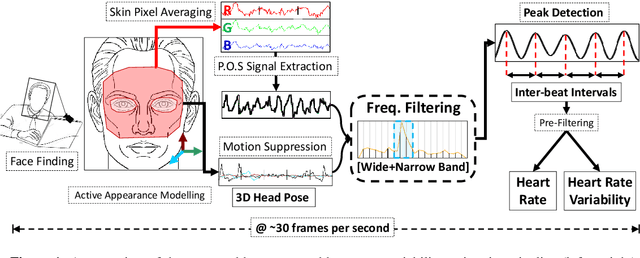

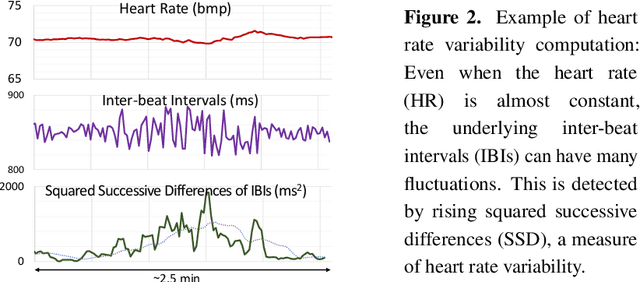

Abstract:Remote photo-plethysmography (rPPG) uses a camera to estimate a person's heart rate (HR). Similar to how heart rate can provide useful information about a person's vital signs, insights about the underlying physio/psychological conditions can be obtained from heart rate variability (HRV). HRV is a measure of the fine fluctuations in the intervals between heart beats. However, this measure requires temporally locating heart beats with a high degree of precision. We introduce a refined and efficient real-time rPPG pipeline with novel filtering and motion suppression that not only estimates heart rates, but also extracts the pulse waveform to time heart beats and measure heart rate variability. This unsupervised method requires no rPPG specific training and is able to operate in real-time. We also introduce a new multi-modal video dataset, VicarPPG 2, specifically designed to evaluate rPPG algorithms on HR and HRV estimation. We validate and study our method under various conditions on a comprehensive range of public and self-recorded datasets, showing state-of-the-art results and providing useful insights into some unique aspects. Lastly, we make available CleanerPPG, a collection of human-verified ground truth peak/heart-beat annotations for existing rPPG datasets. These verified annotations should make future evaluations and benchmarking of rPPG algorithms more accurate, standardized and fair.
* Published in the MDPI Applied Sciences journal special issue Video Analysis for Health Monitoring on December 2, 2020. arXiv admin note: text overlap with arXiv:1909.01206
Efficient Real-Time Camera Based Estimation of Heart Rate and Its Variability
Sep 03, 2019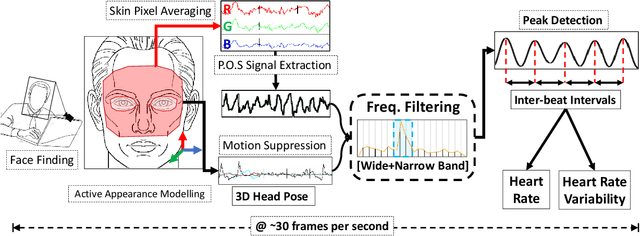
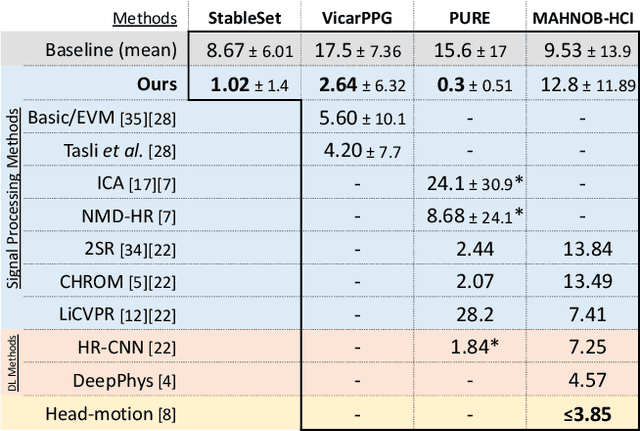
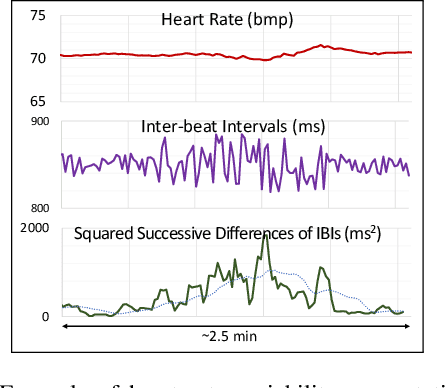

Abstract:Remote photo-plethysmography (rPPG) uses a remotely placed camera to estimating a person's heart rate (HR). Similar to how heart rate can provide useful information about a person's vital signs, insights about the underlying physio/psychological conditions can be obtained from heart rate variability (HRV). HRV is a measure of the fine fluctuations in the intervals between heart beats. However, this measure requires temporally locating heart beats with a high degree of precision. We introduce a refined and efficient real-time rPPG pipeline with novel filtering and motion suppression that not only estimates heart rate more accurately, but also extracts the pulse waveform to time heart beats and measure heart rate variability. This method requires no rPPG specific training and is able to operate in real-time. We validate our method on a self-recorded dataset under an idealized lab setting, and show state-of-the-art results on two public dataset with realistic conditions (VicarPPG and PURE).
 Add to Chrome
Add to Chrome Add to Firefox
Add to Firefox Add to Edge
Add to Edge